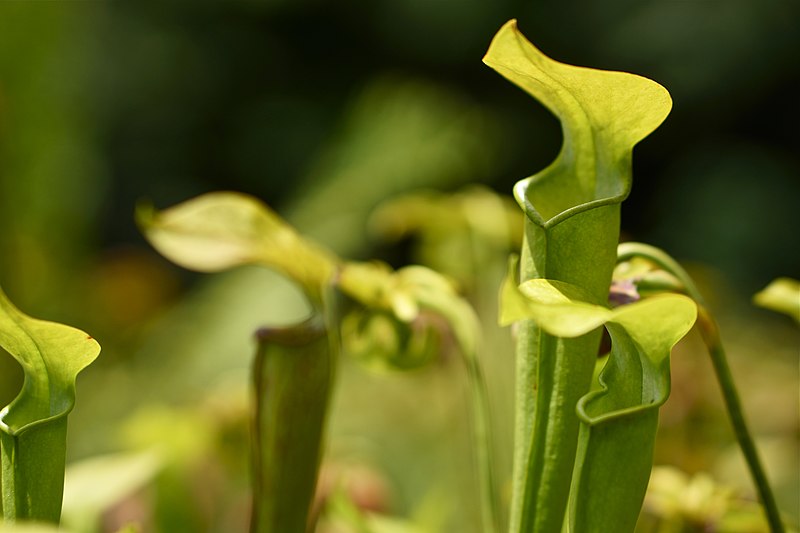File:Mountain sweet pitcher plant (9663267075).jpg

Original file (6,000 × 4,000 pixels, file size: 11.52 MB, MIME type: image/jpeg)
Captions
Captions
Summary edit
| DescriptionMountain sweet pitcher plant (9663267075).jpg |
Researchers at the University of North Carolina at Asheville are working with the U.S. Fish & Wildlife Service to learn more about rare pitcher plants. Pitcher plants have a modified leaf in the shape of a pitcher. The pitcher is lined with tiny, downward-facing hairs. In many pitcher plants, an insect is attracted to the pitcher's scent, begins climbing down, and the hairs prevent it from reversing course, leaving its only option to go deeper, until it comes to the pool of enzymes, is digested, and feeds the plant. However, in other pitcher plants, the plants get others to do much of this work. In the purple pitcher plant, which is found in western North Carolina, the pool of water at the base of the pitcher is home to a community of life, with 165 species found living within its pitchers. In these cases, it's this community of life that does the digesting, and the plant absorbs nutrients released as these other species feed and grow. The purple pitcher plant hybridizes with the endangered mountain sweet pitcher plant, which uses enzymes to digest insects. Two different pitcher plants. Two different feeding strategies. What happens in their offspring? That's one of the questions the researchers hope to answer. By periodically collecting and examining water from the pitchers, they'll gain an understanding of how both communities of life and enzyme solutions vary among the purple, mountain sweet, and hybrid pitcher plants. |
| Date | |
| Source |
|
| Author | U.S. Fish and Wildlife Service Southeast Region |
Licensing edit
- You are free:
- to share – to copy, distribute and transmit the work
- to remix – to adapt the work
- Under the following conditions:
- attribution – You must give appropriate credit, provide a link to the license, and indicate if changes were made. You may do so in any reasonable manner, but not in any way that suggests the licensor endorses you or your use.
| This image, originally posted to Flickr, was reviewed on 24 November 2013 by the administrator or reviewer File Upload Bot (Magnus Manske), who confirmed that it was available on Flickr under the stated license on that date. |
| Public domainPublic domainfalsefalse |
This image or recording is the work of a U.S. Fish and Wildlife Service employee, taken or made as part of that person's official duties. As a work of the U.S. federal government, the image is in the public domain. For more information, see the Fish and Wildlife Service copyright policy.
العربيَّة ∙ català ∙ čeština ∙ eesti ∙ English ∙ español ∙ français ∙ italiano ∙ Nederlands ∙ polski ∙ português ∙ sicilianu ∙ suomi ∙ svenska ∙ Tiếng Việt ∙ Türkçe ∙ Zazaki ∙ македонски ∙ русский ∙ українська ∙ 日本語 ∙ 中文 ∙ 中文(简体) ∙ 中文(繁體) ∙ +/− |
 |
File history
Click on a date/time to view the file as it appeared at that time.
| Date/Time | Thumbnail | Dimensions | User | Comment | |
|---|---|---|---|---|---|
| current | 03:20, 24 November 2013 |  | 6,000 × 4,000 (11.52 MB) | File Upload Bot (Magnus Manske) (talk | contribs) | Transferred from Flickr by User:AlbertHerring |
You cannot overwrite this file.
File usage on Commons
There are no pages that use this file.
Metadata
This file contains additional information such as Exif metadata which may have been added by the digital camera, scanner, or software program used to create or digitize it. If the file has been modified from its original state, some details such as the timestamp may not fully reflect those of the original file. The timestamp is only as accurate as the clock in the camera, and it may be completely wrong.
| Camera manufacturer | SONY |
|---|---|
| Camera model | NEX-7 |
| Exposure time | 1/1,600 sec (0.000625) |
| F-number | f/2.5 |
| ISO speed rating | 100 |
| Date and time of data generation | 14:24, 2 August 2013 |
| Lens focal length | 50 mm |
| Orientation | Normal |
| Horizontal resolution | 72 dpi |
| Vertical resolution | 72 dpi |
| Software used | QuickTime 7.6.6 |
| File change date and time | 22:20, 5 August 2013 |
| Exposure Program | Aperture priority |
| Exif version | 2.2 |
| Date and time of digitizing | 14:24, 2 August 2013 |
| Image compression mode | 1 |
| APEX brightness | 8.06796875 |
| APEX exposure bias | 0 |
| Maximum land aperture | 1.6953125 APEX (f/1.8) |
| Metering mode | Pattern |
| Light source | Unknown |
| Flash | Flash did not fire, compulsory flash suppression |
| Supported Flashpix version | 1 |
| Color space | sRGB |
| Custom image processing | Normal process |
| Exposure mode | Auto exposure |
| White balance | Auto white balance |
| Focal length in 35 mm film | 75 mm |
| Scene capture type | Standard |
| Contrast | Normal |
| Saturation | Normal |
| Sharpness | Normal |